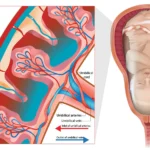Vaginal discharge sign of pregnancy is the most common condition in every woman. But most women have the doubt that is it really a sign of pregnancy? The fact is that there will be a great change in the amount of vaginal discharge during pregnancy.
Usually, all the women have normal vaginal discharge that doesn’t have any odor or just a mild odor and has milky consistency.
Vaginal discharge sign of pregnancy is more visible when you are pregnant. Increased estrogen levels during pregnancy can cause increased vaginal discharge. Blood flow to the vaginal area may also increase during pregnancy. Pregnancy vaginal discharge includes cervical and vaginal secretions, some of the old cells from the vagina along with normal discharge.
When you are almost near to the labor, you will observe more discharge from the vagina, which indicated a sign that at any time you will give birth to your baby. When you are in the initial stages of pregnancy, all the secretions will form as a barrier at the cervical entrance, which is called the mucus plug. When the cervical dilation starts, the mucus plug starts expelling, the discharge looks like egg white or something like mucus from a runny nose.

You should be careful when the vaginal discharge sign of pregnancy becomes thin and clear as it can be a sign of leakage of amniotic fluid. Frankly speaking, it is tough, to tell the truth, in case you have any doubt regarding the vaginal fluid, you should consult your care provider.
Increased vaginal discharge during 36th or 37th week of pregnancy can be a sign of preterm labor, so you should immediately contact your care provider. In case you won’t experience any discharge, it doesn’t mean that you are pregnant. Even the absence of discharge can also be a sign of early pregnancy. If you are still in dilemma of pregnant or not, then it is better to consult your doctor for a test.
Instead of clear or milky white, if you observe foul-smelling and colored vaginal discharge along with itchiness, then immediately you need to consult your doctor. This can be a sign of bacterial or viral infection or an STD, which should be treated. Also, you should discuss with the doctor if you feel that you have any infection.






